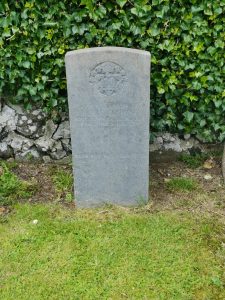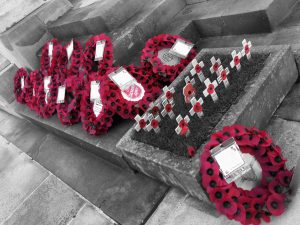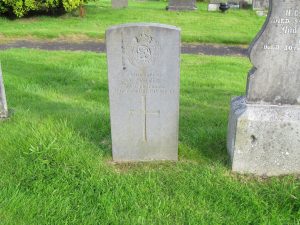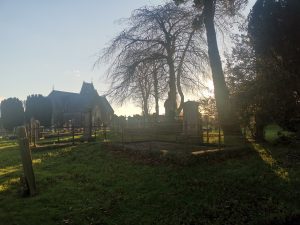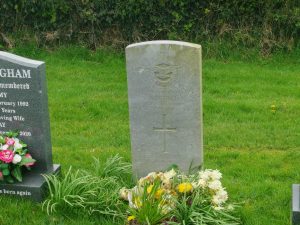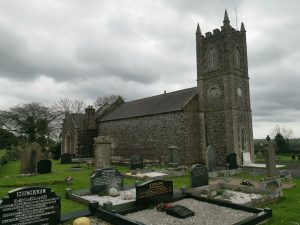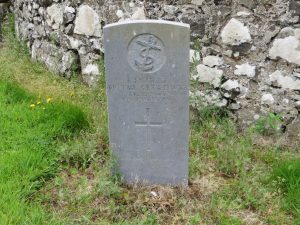Donaghy, P (Patrick)

Donaghy, P (Patrick)
Private Patrick Donaghy was the son of Owen and Mary Donaghy, of Lettermuck, Ballyarton, Cumber-Claudy, Co. Londonderry.
Patrick’s war began when he landed in France on the 17th of December 1915 with the 8th Battalion, Royal Munster Fusiliers at Le Harve via Southampton after leaving the army camp in Blackdown, England, where they had been training since the previous September.
At Le Harve the entire battalion entrained and travelled to Saint-Omer in northern France, close to the Belgium border.[1] They detrained and marched to Verquin.[2] Here they were billeted.
During the afternoon of Christmas Eve, the first troops left for their first trench experience by motor bus from their billets. By 10pm their first casualty had been received, 2nd Lieutenant Patrick McMahon who was seriously wounded.[3] He would stay alive for Christmas, but not for the new year.
The new year, 1916, found the battalion moving from place to place, slowly building their casualty list as they were tested in trenches by the heavy guns and snipers the German army. This continued until April when they were withdrawn to Rue du Haut Prieur.[4] While here they marched to Lillers[5] to celebrate Saint Patrick’s Day with a church parade, followed by brigade sports, of which the battalion won 5 out of 7 events. The men also received a message from General Charles Monro[6] wishing the brigade the best on “St Patrick’s Day”.
Training and recovery continued until the 25th of March when they departed for Philosophe.[7] Once they arrived back in the front line, the casualties almost immediately began, although low in numbers. Bullets and shells were exchanged daily and on the 15th of April 2016 a bad omen was recorded in the War Diary, unknown to their commanding officer, or probably anyone else. The message was simply “Relieved by the 7th Leinster Regiment”, unknown to most this was the regiment their first casualty and fatality, Second Lieutenant Patrick McMahon belonged to before receiving his commission.
While still in Philosophe, on the 10th of May 1916 the Germans put up boards, on which was written “Irishmen? Heavy uproar in Ireland; English guns are being fired at your wives and children! 1st May 1916”. The German dates were slightly wrong, but there was an uprising back in Ireland against British rule between the 24th of April and the 29th. The “Easter Rising” resulted in death of around 485 civilians, soldiers, and rebels. Executions of the leaders soon followed.
The battalion were now involved in mainly trench maintenance and patrols. They took part in raids during the beginning of June, with 18 casualties. They were soon relieved though by the 6th Inniskillings and then withdrew from the line to Noeux Les Mines,[8] where they attended church services and had divisional parchment certificate awards presented to them. By the 18th of the month trench maintenance and patrols had resumed.
Up until the 5th of July 1916 there were only 58 casualties. Unfortunately, Patrick was one of them. It is unknown what happened to him or when he returned to duty.
Meanwhile the battalion continued training, patrolling, repairing, and taking casualties, with short breaks for more awards, bathing, and more training. They also spent time doing the same in Mazingarbe.[9] The latter half of the month saw the battalion receive 125 more casualties, mostly from a trench raid on the 29th of July.
The circle of routine, repairs and casualties continued right through to September when on the 3rd the battalion arrived at Guillemont, in the Somme area. On that day and the day that followed saw them advance across no-man’s land with the 6th Connaught’s[10]. 265 casualties were received in this raid. 80 more on the 9th. The men were now withdrawn from the front line until October when they returned to their previous duties of training, cleaning kit, trench repairs and maintenance. By the end of the month of November the 8th Battalion Royal Munster Fusiliers were no more. The remaining men were absorbed into 1st Battalion, 467 men and officers. There were just not enough volunteers to fill the gaps created by the slaughter on the Western Front.
The men of the 8th joined the men of the 1st at Curragh Camp, on the Westoutre-Locre[11] Road. The strength of the battalion was now 1117 men and officers. By the end of the month, they were back in the trenches.
January 1917 began with the battalion relieving the 7th Leinsters, 1035 men, all ranks. The numbers would vary only slightly through the next few months as they moved from place to place, manning trenches, relieving, training, resting and marching.
June 1917 found the 1st Battalion Royal Munster Fusiliers in Wytschaete,[12] manning trenches awaiting to advance on the fortified village. It began with two large mines exploding in front of them (there were seven in all in the battle). Then every artillery piece in the area opened fire. The men advanced once they gave some time for the main debris to settle. They had tanks in support.
The defenders, who were the German 2nd Division were now devastated, but they still put up some defence, although this was bypassed or neutralised quickly. Within a few hours the battalion was in control of the village and were passing back hundreds of relieved prisoners who had survived the onslaught. By the end of the battle the battalion had suffered 114 casualties. Private Patrick Donaghy was one of them. It is unknown how he was wounded, but he would though return to the battalion on a later date and possibly be wounded again during July.
The battalion itself would continue the routine of life at the front, receiving daily casualties throughout the summer and autumn in various places. 1918 found them involved in several battles and the occupation of Lille in France. This is where they ended their war. It is unknown how much Patrick was involved throughout that year, but by March 1919 he succumbed to an illness in Oswestry Military Hospital, Shropshire, England. His body was brought home and he was laid to rest.
Patrick was awarded the 1914/15 Star, the British War and Victory Medals.
Date of Death: 07/03/1919 (Aged 22)
Service: 8th Battalion Royal Munster Fusiliers and 1st Battalion Royal Munster Fusiliers
Service Number: 4289
Burial Location: In South-East part (left of main path)
[1] The journey from Le Harve to Saint-Omer is around 150 miles.
[2] Verquin is around 30 miles south east of Saint-Omer.
[3] Second Lieutenant Patrick McMahon had previously served with the 7th Leinster Regiment as a Private, (service number 2303) and was only 28 when he passed away at 11 am on the 29th of December 1915 in Bethune hospital, France. He was laid to rest in Bethune town cemetery.
[4] Rue du Haut Prieur is located in the north west of France.
[5] Lillers is about 10 miles to the west of Rue du Haut Prieur.
[6] General Charles Monro had taken command of the First Army in January 1916 after returning from the evacuation of Gallipoli.
[7] Philosophe is around 10 miles southeast from Rue du Haut Prieur.
[8] Noeux Les Mines is a commune area in Northern France.
[9] Mazingarbe is just east of Noeux Les Mines
[10] 6th Connaught’s are the 6th Connaught’s Rangers Battalion, they received around 430 casualties during their week at the Somme.
[11] Westoutre is located near the French border in southwest Belgium, about 8 miles southwest of Ypres.
[12] Wytschaete is around 6 miles to the east of Westoutre in southern Belgium.
